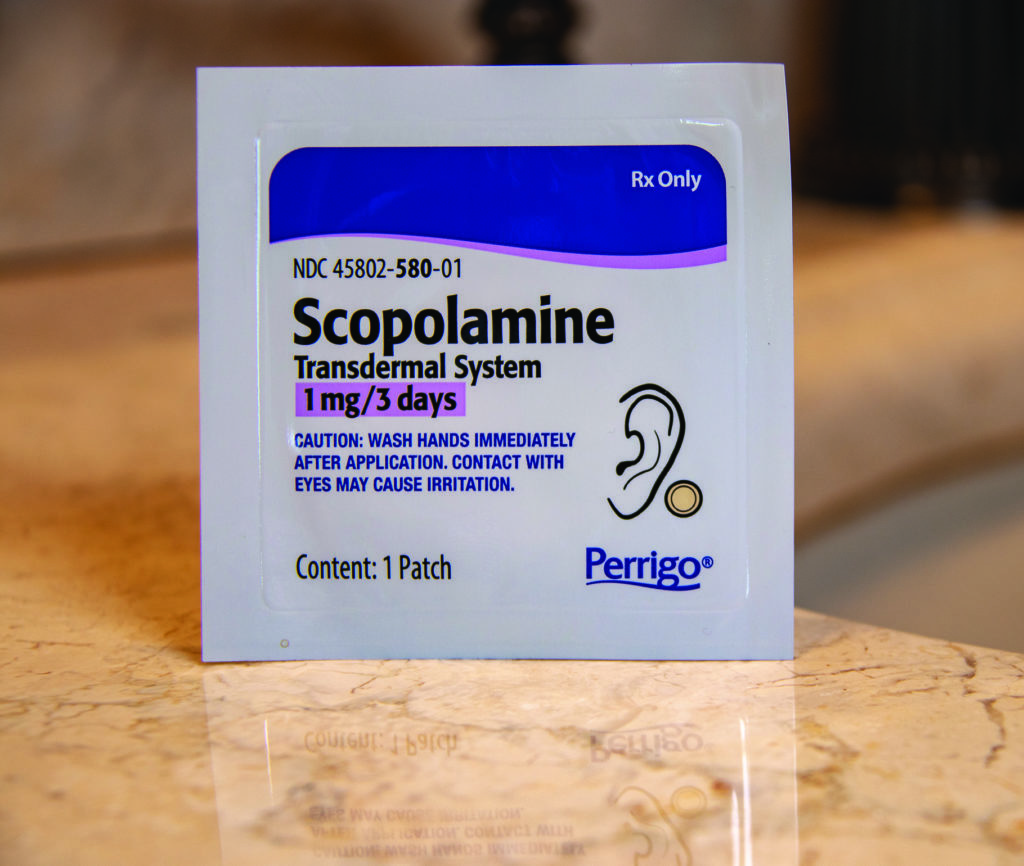MOTION SICKNESS

Motion sickness (also known as seasickness) is a common complaint of travelers on planes, boats, motor vehicles and even animals such as camels.
Symptoms: The most distressing symptoms of motion sickness are nausea and vomiting, caused by an overstimulation of the inner ear’s vestibular balance organs and a mismatch between the sensory input from the eyes and inner ears. Other symptoms include excessive sweating, pallor (pale skin), mild headache and generally ill-feeling. Motion sickness is not a severe medical problem, but it may lead to dive incidents because affected individuals can develop an almost desperate inattentiveness and reduced ability to perform common tasks.
The most common symptoms of motion sickness — dizziness and nausea — may also signal other injuries, especially in divers.
Treatment: Treatment options include oral drugs or a transdermal patch, which is a medicated patch that delivers medication through the skin. A physician should evaluate persistent or unusually severe nausea, especially if other symptoms are present.
Oral drugs to treat motion sickness vary in their effectiveness and side effects among individuals. Use such drugs with caution during certain activities because most of them cause mild drowsiness and inhibit mucous secretions.
Transdermal delivery of the prescription drug scopolamine can be effective in many people. Known by the brand name Transderm Scop, the patch contains 1.5 milligrams of scopolamine and delivers the drug at a constant rate for three days when placed on the skin (typically just behind the ear). Remove the patch after three days. You can apply another patch if needed, but never wear more than one patch at a time, even if you think one is exhausted, to prevent too much medication from entering your bloodstream and causing undesirable side effects.
Side effects of scopolamine include dry mouth, drowsiness and blurred vision or a dilated pupil that could prompt an unnecessary evacuation or chamber treatment. Disorientation, memory disturbances, dizziness and restlessness may occur less frequently. Patients with narrow-angle glaucoma, a pyloric obstruction or a urinary bladder neck obstruction (such as an enlarged prostate) should use scopolamine with caution. Rare side effects include hallucinations, confusion, difficulty urinating, skin rashes and eye pain.
There is no way to know in advance who will be affected and how, so it is advisable to wear a scopolamine patch for at least 24 hours to test its effects before you need it to prevent motion sickness. Do not consume alcohol while wearing a patch.
After opening the foil wrapper, avoid touching the patch under the plastic strip; if you get medication on your finger and accidentally touch your eye, the drug could cause dilation of the affected pupil and be absorbed too rapidly.
If side effects occur, remove the patch. Withdrawal symptoms can occur when a patch is removed if it is worn for more than three days. These symptoms can include dizziness, nausea, vomiting, headache and balance disturbances and generally do not occur until 24 hours after patch removal.
Although mostly anecdotal and in many cases not scientifically proven, other remedies that might work against motion sickness include acupuncture, acupressure bands that stimulate certain pressure points on the wrist,18 avoiding histamine-rich foods before and during the trip, taking vitamin C or eating vitamin C-rich foods and making sure that you are well rested before the trip.19,20 If you are susceptible to motion sickness, you will need to find your own way to handle and mitigate it since there is no 100 percent effective solution for everyone.
Prevention: Closing your eyes or sitting where a boat’s rocking motion is not visible can help prevent motion sickness. Gazing at the horizon rather than at objects in your immediate vicinity can also help. Stay away from areas with strong fumes, particularly fuel, and any other smell that you usually consider obnoxious.
Considerations for divers: Motion sickness can be hazardous in scuba divers, who may want to quickly get into the water to reduce the disorder’s effects, thereby lessening the care they take in setting up their equipment or attending to their buddy. Vomiting underwater can be a real problem if divers foul their regulator’s second stage or inhale water. It is not true that vomiting underwater is necessarily followed by an uncontrollable inhalation reflex, but coughing or choking can occur. Removing a regulator to vomit into the water keeps it clean but must be done with great care. Divers who are seriously affected by motion sickness should avoid starting a dive until their symptoms improve.
Divers should be cautious when using oral drugs for motion sickness, because the possible side effects of mild drowsiness and decreased mucous secretions can be a problem in diving. A scopolamine patch is the preferred treatment; the U.S. Navy has evaluated the patch and found it to have minimal adverse effects in divers
Withdrawal symptoms such as dizziness, nausea, vomiting, headache and balance disturbances — which can occur if a patch is used too long — are also associated with decompression sickness (see also Section 5: Scuba Diving). A diagnosis can be complicated if a diver removes a patch right after making a deep dive. Tell medical personnel if you develop these symptoms after diving and if you wore a transdermal patch at any time.
Although mild motion sickness is often relieved once you get underwater, exercise caution if you experience severe nausea. It may be best to cancel the dive.

Transdermal delivery of the prescription drug scopolamine can be effective in many people.

Transdermal delivery of the prescription drug scopolamine can be effective in many people.
Although mild motion sickness is often relieved once you get underwater, exercise caution if you experience severe nausea. It may be best to cancel the dive.
DAN Customer Service
Mon–Fri, 8:30 a.m. – 5 p.m. ET
+1 (919) 684-2948
+1 (800) 446-2671
Fax: +1 (919) 490-6630
24/7 Emergency Hotline
In event of a dive accident or injury, call local EMS first, then call DAN.
24/7 Emergency Hotline:
+1 (919) 684-9111
(Collect calls accepted)
DAN must arrange transportation for covered emergency medical evacuation fees to be paid.
Medical Information Line
Get answers to your nonemergency health and diving questions.
Mon–Fri, 8:30 a.m. – 5 p.m. ET
+1 (919) 684-2948, Option 4
Online: Ask A Medic
(Allow 24-48 hours for a response.)